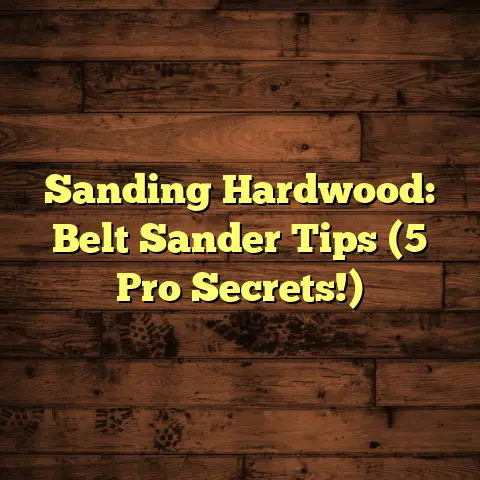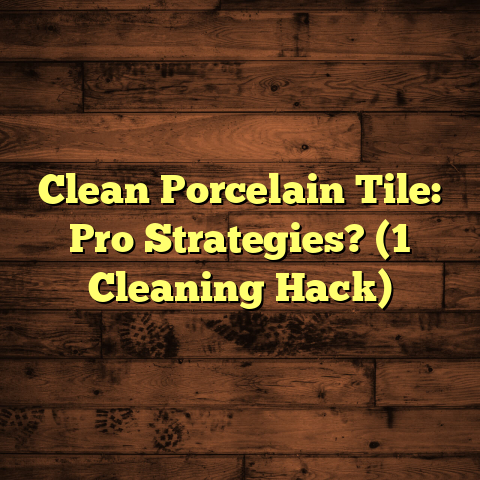Refinishing Hardwood Floors? (7 Tools Needed!)
I get it.
As a flooring contractor for over 15 years,
I’ve seen hardwood floors go from stunning to “meh”
simply due to wear and tear.
Think about it: daily foot traffic, kids playing,
furniture shifting, even the sun’s UV rays – they
all take a toll.
Your once-gorgeous floors can
become scratched, dull, and lose their luster.
But don’t despair!
Maintaining your hardwood
isn’t just about aesthetics; it’s about preserving
your home’s value and ensuring the longevity
of your investment.
That’s where refinishing comes in.
Refinishing breathes new life into tired hardwood,
restoring its beauty and protecting it for years to come.
And the best part?
With the right tools and a little
know-how, it’s a project you can totally tackle yourself.
So, if you’re ready to transform your floors from drab to fab, let’s dive into the seven essential tools you’ll need to refinish your hardwood like a pro.
Section 1: Understanding the Need for Refinishing
Okay, so how do you know if your hardwood floors
are screaming for a makeover?
Let’s talk signs.
Visible Scratches: These are the most obvious culprits.
Light scratches might just need a touch-up, but deep
scratches that penetrate the finish indicate it’s time
for a full refinish.
I’ve seen floors where you could
practically trace the family dog’s daily route!
Fading: Sunlight is a blessing and a curse.
While it brightens your home, it can also fade
your hardwood over time, especially in areas
exposed to direct sunlight.
This uneven color
change is a telltale sign of needing a refresh.
Water Damage: Water and wood are not friends.
Spills, leaks, or even high humidity can cause
water damage, leading to staining, warping, or
cupping of the boards.
If you spot any of these,
refinishing (and addressing the source of the water)
is crucial.
Dullness: Even without obvious damage, your
floors can simply lose their shine over time.
The
protective finish wears down, leaving the wood
looking lifeless.
Benefits of Refinishing:
Enhanced Appearance: This one’s a no-brainer.
Refinishing brings back the original beauty of your hardwood, making your entire home feel fresher and more inviting.Increased Property Value: According to the National Association of Realtors, refinishing hardwood floors can increase your home’s value.
Potential buyers love well-maintained hardwood!Prolonged Life: Refinishing protects the wood from further damage, extending its lifespan.
Think of it as giving your floors a new lease on life.
How Often to Refinish?
This depends on a few factors:
-
Foot Traffic: High-traffic areas like hallways and living rooms will need refinishing more often than bedrooms.
-
Type of Finish: Polyurethane finishes are durable and can last longer than wax finishes.
-
Lifestyle: Pets and kids can be tough on floors!
As a general rule, I recommend refinishing every
7-10 years for high-traffic areas and every 10-15
years for lower-traffic areas.
However, always
assess the condition of your floors and address
any issues promptly.
Section 2: Overview of the Refinishing Process
Before we get into the nitty-gritty of the tools,
let’s quickly walk through the refinishing process.
This will give you context for why each tool is so important.
1. Preparation:
Clear the Area: Remove all furniture, rugs, and anything else from the room.
Trust me, you don’t want to be sanding around a piano!Clean the Floors: Sweep, vacuum, and even use a damp cloth to remove any dirt, dust, or debris.
A clean surface is essential for proper sanding.
2. Sanding:
Rough Sanding: This is where you remove the old finish and level out any imperfections.
You’ll typically start with a coarse grit sandpaper.-
Medium Sanding: This smooths out the scratches left by the rough sanding.
-
Fine Sanding: This is the final sanding stage, creating a super-smooth surface for staining and finishing.
3. Staining (Optional):
-
If you want to change the color of your floors, now’s the time to apply stain.
-
Apply the stain evenly, following the manufacturer’s instructions.
-
Allow the stain to dry completely before moving on.
4. Finishing:
-
Apply several coats of a protective finish, such as polyurethane.
-
Allow each coat to dry completely before applying the next.
-
Lightly sand between coats for an even smoother finish.
5. Buffing (Optional):
- Buffing can help to smooth the final coat of finish and create a more professional look.
6. Curing:
- Allow the finish to fully cure before moving furniture
back into the room.
This can take several days, depending on the type of finish you use.
Remember, this is just a high-level overview.
Each step involves specific techniques and considerations.
But don’t worry, we’ll get into more detail as we
discuss the tools.
Section 3: Essential Tools for Refinishing Hardwood Floors
Alright, let’s get to the heart of the matter: the tools you’ll need to conquer this project.
1. Sander
The sander is the MVP of hardwood floor refinishing.
It’s what removes the old finish, levels the surface,
and prepares the wood for staining and finishing.
Types of Sanders:
Drum Sander: This is the workhorse of floor sanders.
It’s powerful and efficient, making it ideal for large areas and removing heavy finishes.
However, it can be aggressive and requires a steady hand to avoid damaging the floor.Orbital Sander (also called Random Orbital Sander): This sander uses a circular motion to remove material.
It’s less aggressive than a drum sander, making it more forgiving for beginners.
It’s great for smaller areas and for the final sanding stages.-
Edge Sander: This sander is designed to sand along edges and in corners, where the drum sander can’t reach.
Importance of Sanding:
Sanding is crucial for several reasons:
-
Removes Old Finish: It gets rid of the worn-out, scratched, and damaged finish, exposing the bare wood.
-
Levels the Surface: It smooths out any imperfections, such as uneven boards or cupping.
-
Prepares for Finishing: It creates a smooth, even surface that will accept stain and finish properly.
Selecting the Right Sander:
Floor Type: For solid hardwood floors, a drum sander is often the best choice for the initial sanding.
For engineered hardwood or softer woods, an orbital sander might be a better option to avoid over-sanding.Condition: If your floors have a thick, tough finish or significant imperfections, a drum sander will be more efficient.
If they’re in relatively good condition, an orbital sander might suffice.Experience Level: If you’re a beginner, an orbital sander is generally easier to control.
Drum sanders require practice and caution.
My Pro Tip: When using a drum sander, always
keep it moving and overlap your passes slightly.
Never stop the sander while it’s on the floor, as
this can create dips.
2. Sandpaper
Sandpaper is the sander’s partner in crime.
It’s what actually does the work of removing
material and smoothing the surface.
Various Grits:
Sandpaper comes in different grits, which refer
to the size of the abrasive particles on the paper.
The lower the grit number, the coarser the sandpaper.
-
Coarse Grit (36-40 grit): Used for the initial sanding to remove the old finish and level out major imperfections.
-
Medium Grit (60-80 grit): Used to smooth out the scratches left by the coarse grit sandpaper.
-
Fine Grit (100-120 grit): Used for the final sanding to create a super-smooth surface for staining and finishing.
Choosing the Correct Sandpaper:
Sander Type: Make sure the sandpaper is compatible with your sander.
Drum sanders typically use sandpaper rolls, while orbital sanders use sandpaper discs.-
Flooring Type: Softer woods require finer grits to avoid over-sanding.
-
Finish Type: If you’re removing a thick, tough finish, you’ll need a coarser grit than if you’re removing a thin, worn finish.
Maintaining Sandpaper Efficiency:
Change Sandpaper Regularly: Sandpaper loses its abrasiveness over time.
Replace it when it starts to become less effective.Clean Sandpaper: Use a brush or compressed air to remove dust and debris from the sandpaper.
This will help it last longer and work more efficiently.-
Avoid Clogging: Don’t apply too much pressure to the sander, as this can cause the sandpaper to clog with dust.
My Pro Tip: Invest in high-quality sandpaper.
It will last longer, cut better, and produce a
smoother finish.
3. Vacuum or Shop Vac
Dust is the enemy of a beautiful finish.
It can contaminate your stain and finish,
creating imperfections and ruining the look
of your floors.
That’s why a good vacuum
or shop vac is essential.
Importance of Dust Removal:
-
Prevents Contamination: Dust particles can get trapped in the stain and finish, creating a rough, uneven surface.
-
Ensures Proper Adhesion: Dust can prevent the stain and finish from adhering properly to the wood.
Improves Air Quality: Sanding creates a lot of dust, which can be harmful to your health.
A vacuum helps to remove the dust from the air, improving air quality.
Features to Look For:
-
Powerful Suction: You need a vacuum that can effectively remove fine wood dust.
-
HEPA Filter: A HEPA filter will trap even the smallest dust particles, preventing them from being recirculated into the air.
-
Hose and Attachments: A hose and various attachments will allow you to reach corners, edges, and other hard-to-reach areas.
Best Practices:
-
Vacuum Frequently: Vacuum the floors thoroughly after each sanding stage.
-
Vacuum Walls and Trim: Dust can settle on walls and trim, so be sure to vacuum these areas as well.
-
Empty Vacuum Regularly: Don’t let the vacuum get too full, as this can reduce its suction power.
My Pro Tip: Use a tack cloth to wipe down the
floors after vacuuming.
This will remove any remaining
dust particles.
4. Stain Applicator
If you’re planning to stain your floors, you’ll need
a stain applicator.
The type of applicator you
choose will affect the look and feel of the stain.
Types of Applicators:
Brushes: Brushes are great for applying stain to edges, corners, and other hard-to-reach areas.
They also allow you to control the amount of stain you apply.Rags: Rags are ideal for applying stain to large areas.
They allow you to create a thin, even coat of stain.Rollers: Rollers are another good option for applying stain to large areas.
They can cover a lot of ground quickly.
Choosing the Right Applicator:
Desired Finish: If you want a rich, dark stain, a brush might be the best choice.
If you want a lighter, more natural-looking stain, a rag or roller might be better.-
Stain Type: Some stains are easier to apply with a brush, while others are easier to apply with a rag or roller.
-
Personal Preference: Ultimately, the best applicator is the one you feel most comfortable using.
Achieving Even Application:
Apply Thin Coats: Don’t apply too much stain at once.
It’s better to apply several thin coats than one thick coat.-
Work in Sections: Divide the floor into small sections and apply stain to each section individually.
-
Wipe Off Excess Stain: After applying the stain, wipe off any excess with a clean rag.
My Pro Tip: Always test the stain on a small,
inconspicuous area of the floor before applying
it to the entire floor.
This will allow you to see
how the stain looks and make sure you’re happy
with the color.
5. Finish Applicator
The finish is what protects your floors from wear
and tear.
It also adds shine and enhances the
beauty of the wood.
Choosing the right finish
applicator is crucial for achieving a smooth,
durable finish.
Overview of Finish Types:
-
Water-Based Polyurethane: This is a popular choice for its durability, low odor, and fast drying time.
Oil-Based Polyurethane: This finish is known for its rich, warm tone and excellent durability.
However, it has a strong odor and takes longer to dry.
Applicator Options:
-
Brushes: Brushes are good for applying finish to edges, corners, and other hard-to-reach areas.
-
Lambswool Applicators: These applicators are designed to apply a smooth, even coat of finish to large areas.
Techniques for Proper Application:
-
Apply Thin Coats: Just like with stain, it’s better to apply several thin coats of finish than one thick coat.
-
Work with the Grain: Apply the finish in the direction of the wood grain.
-
Avoid Streaks and Bubbles: Use a smooth, even motion to avoid streaks and bubbles.
-
Sand Between Coats: Lightly sand between coats of finish with fine-grit sandpaper to create an even smoother finish.
My Pro Tip: Use a high-quality finish applicator.
It will make a big difference in the final result.
6. Protective Gear
Refinishing hardwood floors can be a dusty and
messy job.
Protecting yourself is essential for
your health and safety.
Importance of Safety Equipment:
Masks: Sanding creates a lot of dust, which can be harmful to your lungs.
A mask will protect you from inhaling dust particles.Goggles: Dust and debris can get into your eyes, causing irritation and injury.
Goggles will protect your eyes.Knee Pads: Refinishing floors involves a lot of kneeling and bending.
Knee pads will protect your knees from pain and injury.
Specific Gear Recommendations:
-
N95 or P100 Mask: These masks are designed to filter out fine dust particles.
-
Safety Goggles: Choose goggles that fit snugly and provide good coverage.
-
Gel Knee Pads: These knee pads are more comfortable than foam knee pads.
Tips for Ensuring Safety and Comfort:
-
Wear Long Sleeves and Pants: This will protect your skin from dust and debris.
-
Work in a Well-Ventilated Area: Open windows and doors to improve air circulation.
Take Breaks: Refinishing floors can be physically demanding.
Take breaks to avoid fatigue and injury.
My Pro Tip: Don’t skimp on safety gear.
It’s worth the investment to protect your health.
7. Floor Buffer
A floor buffer is a machine that’s used to polish
and smooth floors.
While it’s not strictly essential,
it can help you achieve a more professional-looking
finish.
How a Floor Buffer Helps:
-
Smooths the Finish: A floor buffer can smooth out any imperfections in the finish, creating a more even surface.
-
Enhances the Shine: A floor buffer can enhance the shine of the finish, making your floors look more beautiful.
Types of Buffers:
Orbital Floor Buffer: This type of buffer uses a circular motion to polish the floor.
It’s less aggressive than a rotary buffer, making it easier to control.Rotary Floor Buffer: This type of buffer uses a spinning pad to polish the floor.
It’s more powerful than an orbital buffer, but it can also be more difficult to control.
Tips for Using a Buffer Effectively:
-
Use the Right Pad: Choose a pad that’s appropriate for the type of finish you’re using.
-
Apply Light Pressure: Don’t apply too much pressure to the buffer, as this can damage the finish.
-
Overlap Your Passes: Overlap your passes slightly to ensure even coverage.
My Pro Tip: If you’re not comfortable using
a floor buffer, you can skip this step.
However,
if you want to achieve a truly professional-looking
finish, it’s worth considering.
Section 4: Conclusion
So, there you have it: the seven essential tools you’ll need to refinish your hardwood floors.
Having the right tools is crucial for a successful
refinishing project.
These tools will help you
remove the old finish, level the surface, apply
stain and finish, and protect yourself from dust
and debris.
Remember, refinishing hardwood floors is a rewarding
DIY project that can enhance both the beauty and
value of your home.
With the right tools and a
little patience, you can transform your tired,
worn-out floors into a stunning centerpiece that
will last for years to come.
Don’t be afraid to give it a try!
You might just
surprise yourself with what you can accomplish.
And who knows, you might even discover a new
passion for home improvement.
Good luck!





